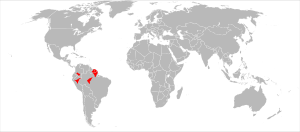Neotropical pygmy squirrel facts for kids
Quick facts for kids Neotropical pygmy squirrel |
|
|---|---|
 |
|
| Conservation status | |
| Scientific classification | |
| Genus: |
Sciurillus
|
| Species: |
pusillus
|
 |
|
| Neotropical pygmy squirrel range | |
The Neotropical pygmy squirrel (Sciurillus pusillus) is a tiny tree squirrel from South America. It is the only living species in its group, called Sciurillus, and its special family, Sciurillinae. Scientists have found that this squirrel is like the "cousin" to all other squirrels.
About This Squirrel
The Neotropical pygmy squirrel is the smallest tree squirrel in the Americas. It is only about 10 cm (4 inches) long from its head to its body. Its tail is about 11 cm (4.3 inches) long. These squirrels weigh between 30 and 48 grams, which is about the same as a few strawberries!
Their fur is mostly grey with a speckled look. Their belly fur is lighter but not super bright. Their head has a slight reddish color. You can spot them by the clear white marks behind their ears. Their ears are shorter and rounder than most other tree squirrels. They have thin legs, and their front legs are longer to help them climb trees. Female squirrels have six teats.
Where They Live
Neotropical pygmy squirrels live in at least four different areas in northern South America. You can find them in French Guiana, Suriname, central Brazil, northern Peru, and southern Colombia.
They prefer to live in warm, wet rainforests that are close to sea level. There are three types of these squirrels, but scientists are still figuring out exactly where each type lives. It's possible they might even be different species!
- S. p. pusillus
- S. p. glaucinus
- S. p. kuhlii
Daily Life and Habits
Neotropical pygmy squirrels are active during the day. This means they are diurnal. They spend their days high up in the trees, usually at least 9 meters (30 feet) off the ground.
They have been seen making their nests inside old termite nests in trees. They line these nests with soft fibers from a tree called machimango.
These squirrels eat by chewing on the bark of trees, especially those from the Parkia group. They probably eat the sticky sap that comes out when the tree is hurt. They might also eat the soft layer under the bark.
There aren't many of these squirrels in one place. Usually, you'll find only a few in a square kilometer. However, sometimes groups with more than one adult and their young are seen. This happens in places where there is a lot of food.
These squirrels move very quickly through the trees. They get excited easily! When they sense danger, they make an alarm call. People say it sounds a lot like a cricket.
Reproduction
Female Neotropical pygmy squirrels usually give birth to one or two babies at a time. Scientists have seen pregnant females in June.
See also
 In Spanish: Ardilla pigmea neotropical para niños
In Spanish: Ardilla pigmea neotropical para niños


